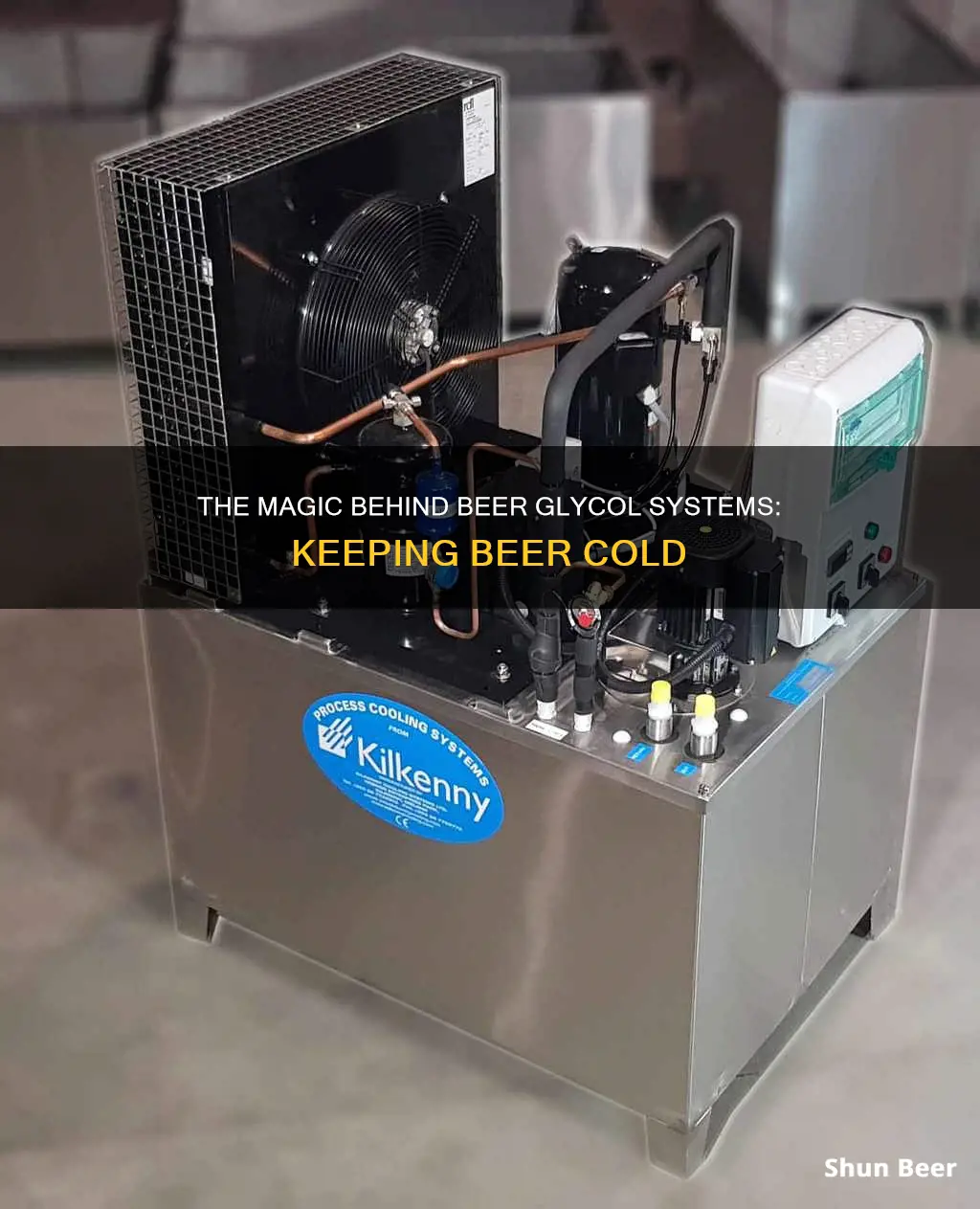
A glycol beer system is a popular method used in bars, pubs, and restaurants to keep beer cold as it travels from the keg to the tap. This system is especially useful for long-draw setups, where the keg is stored far away from the dispensing tower. The main component of this system is propylene glycol, a food-grade antifreeze that is pumped through the lines to keep the beer cold. The glycol is chilled and circulated by a power pack, which is a commercial refrigeration unit. This system helps to prevent foam buildup and ensures that the beer is served at the optimal temperature for the best flavor profile.
What You'll Learn

The role of the glycol power pack
The glycol power pack is the heart of a glycol tap system. It is a compact, commercial refrigeration unit that pumps and circulates glycol through the system, maintaining the proper temperature.
A power pack consists of a thermostat, a glycol reservoir with a coil, and supply and return lines. The thermostat regulates the temperature, while the coil contains a refrigerant to cool the glycol in the reservoir. The circulation pump runs continuously, forcing glycol through the supply line. The compressor runs on and off as needed to maintain the set temperature.
The power pack pushes refrigeration (glycol) through the trunk line, which can include up to four glycol lines: outbound glycol lines that run from the power pack to the tower, and return glycol lines that enable the refrigerant to complete the cycle and become re-chilled.
The glycol power pack ensures that beer is kept at a constant temperature of around 36-38°F (2-3°C) as it travels from the walk-in cooler to the dispensing tower. This helps to prevent foam buildup and ensures that every pint poured is perfectly chilled.
Glycol power packs are available in various sizes and configurations to meet the specific needs of different glycol draft beer systems. They are highly efficient, require minimal maintenance, and are ideal for large-scale commercial operations.
How Well Does Mr. Beer Work for Beginners?
You may want to see also

The trunk line explained
The trunk line is a crucial component of a glycol beer system, acting as the "blood vessel" that transports chilled beer from the walk-in cooler to the dispensing tower. It is designed to maintain the cold temperature of the beer as it travels over a significant distance, ensuring that it reaches the tap at the ideal serving temperature of 36-38 degrees Fahrenheit.
The trunk line consists of multiple beer lines, typically ranging from 4 to 10, bundled together with a pair of glycol refrigeration lines. These glycol lines are responsible for keeping the beer chilled during transport. One glycol line carries the coolant from the power pack to the beer tower, while the other returns it to the power pack to complete the refrigeration cycle.
The beer lines within the trunk line are connected to individual kegs stored in the walk-in cooler. This allows for the simultaneous dispensing of different beers, with each keg linked to its corresponding faucet in the tower. The trunk line's insulation ensures that the beer remains cold and that the glycol coolant maintains its temperature as well.
The installation of the trunk line can be done either overhead or under the floor. Overhead installations often use PVC tubing and a decorative finish to conceal the trunk line, while under-floor installations involve running the lines through PVC tubing. Proper insulation is crucial to prevent temperature fluctuations and ensure the beer remains chilled.
The trunk line plays a vital role in the glycol beer system, facilitating the delivery of cold beer over long distances while maintaining optimal serving temperatures. Its design, with multiple beer lines and glycol refrigeration lines, ensures that beer can be dispensed at multiple locations while preserving its quality and flavour.
Colorado EBT and Beer: What's the Deal?
You may want to see also

How to install glycol trunklines
To install glycol trunklines, you will first need to decide on the number of beer lines and glycol lines you require. This will depend on the length of your beer run and the number of products you are dispensing. For instance, a 10-16 product trunkline will feature 4 glycol lines, while a 2-8 product trunkline will feature 2 glycol lines.
Once you have decided on the number of lines, you can purchase the trunkline, which is sold by the foot. You will also need to purchase PVC tubing, tape for insulation, and, optionally, foil wrap.
The trunkline can be installed overhead or under the floor. If installed overhead, the exposed lines will be housed in a combination of PVC tubing and a decorative finish. If installed under concrete, the lines will be run through PVC tubing.
To install the trunkline, simply attach it to the rest of your glycol cooling system using the layer of tape provided. The tape provides flexibility for easy installation and minimal gapping. If using foil wrap, apply it over the internal moisture barrier to prevent condensation and efficiently transfer cold from the glycol lines to the beer lines.
Krusteaz Buttermilk: The Perfect Beer Batter Base?
You may want to see also

Maintaining the temperature of the draft beer
Maintaining the temperature of draft beer is the primary function of a glycol system. The glycol power pack, or chiller, is the component responsible for this. The power pack is a compact commercial refrigeration unit that pumps and cools the glycol in the system, ensuring the beer in the lines is always at the correct serving temperature. The glycol is pumped through the centre of the trunk line, which contains up to four glycol lines: outbound glycol lines (running from the power pack to the tower) and return glycol lines (enabling the refrigerant to complete its cycle and become re-chilled).
The power pack maintains a constant beer temperature of 36-38 degrees Fahrenheit (2-3 degrees Celsius). This temperature is ideal for achieving the best flavour profile and maximising keg yield.
The trunk line is an insulated bundle of beer lines and glycol lines. The beer lines are connected to unique kegs in the walk-in cooler, and the glycol lines are sealed and wrapped in foil to keep the beer insulated from the ambient temperature. The trunk line can be up to 750 feet in length and can handle up to 24 beer products.
The final component in maintaining the temperature of the beer is the beer tower. As the beer travels through the trunk line, it experiences a temporary temperature rise due to the pressure of the gas pushing it and the drag caused by the plastic product lines. The beer tower is designed to prevent further temperature gain over the final segment of the beer's journey. The tower has a stainless steel shank behind each beer faucet, surrounded by a copper assembly known as the "cold block". The inbound glycol refrigerant line enters the tower and travels vertically inside, returning to the power pack. This loop contacts the shank of each faucet and branches into each faucet, controlling the temperature of the beer to the end of the faucet.
Glycol systems are highly efficient and can last for years, or even decades, with simple annual maintenance and checks. To maintain the system, it is important to keep the glycol level in the unit full and to change the glycol in the system annually.
Understanding Beer Staffs: A Guide to Their Functionality
You may want to see also

The function of the glycol beer tower
A glycol beer tower is an essential component of a glycol beer system, which is a popular method for serving cold beer in bars, pubs, tap rooms, and restaurants. The glycol beer tower plays a critical role in maintaining the ideal temperature for dispensing beer, ensuring customers receive a perfectly chilled beverage.
The glycol beer tower is designed to keep the beer cold as it travels from the storage keg to the faucet. It achieves this by having glycol lines running inside the tower, often in direct contact with the beer shanks. This innovative design ensures that the beer remains at the optimal temperature of 36-38° F (2-3° C) until it reaches the customer's glass.
The glycol lines within the tower are part of a continuous loop that circulates chilled glycol through the system. The glycol is cooled in a reservoir by a glycol chiller, which is a piece of equipment that is crucial to the entire glycol beer system. The glycol then flows through the glycol lines, including those in the tower, maintaining a constant temperature.
The beer lines are connected to the shank or faucet inside the beer tower. When the tap handle is pulled, fresh, cold beer is dispensed. The glycol beer tower's ability to regulate temperature ensures that the beer is delivered at the ideal temperature, enhancing the flavour profile and maximising the yield from each keg.
The glycol beer tower's functionality is a key advantage of glycol beer systems, allowing establishments to dispense beer at multiple bar stations while using a single consolidated beer cooler. This flexibility makes it a popular choice for businesses looking to serve cold, delicious beer to their customers efficiently and effectively.
Beer and Ice Cream: A Match Made in Heaven?
You may want to see also
Frequently asked questions
A glycol beer system is a tap system that uses glycol to keep beer at the optimal temperature of 36-38 degrees Fahrenheit for dispensing. Glycol is a food-grade antifreeze, also known as propylene glycol, and is also used as a lubricant for the pumps on glycol chillers.
A glycol chiller cools the glycol and circulates it through the draft beer system. The glycol is pumped through lines that run alongside the beer lines, keeping the beer chilled. The glycol never comes into contact with the beer.
The glycol power pack is the heart of the glycol system. It is a commercial refrigeration unit that pumps and cools the glycol in the system. It consists of a thermostat, a glycol reservoir with a coil, and supply and return lines.
The trunk line is a bundle of beer lines and glycol refrigeration lines that are wrapped in insulation. The beer lines connect the kegs of beer in the walk-in cooler to the faucets in the beer tower. The glycol lines keep the beer chilled as it travels through the trunk line.







